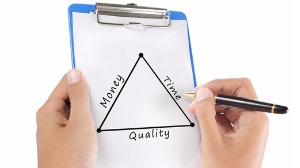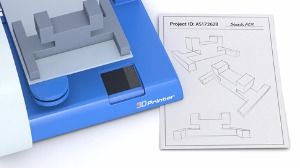In the process of going from idea to product, time can be one of your biggest obstacles. No matter how eager you are to get your product to market, each step of the process takes time — which goes hand in hand with monetary investment, to say nothing of the challenges that can rear their heads at every stage. For all too many inventors and product developers, the time required to go from idea to product can be discouraging, which can further slow the process. Or, in some cases, can cause you to abandon it altogether. In fact, until recently, prototypes could take four to six weeks — or longer — to create.

There aren’t any shortcuts in product or prototype development, but there are optimal, efficient and better ways of doing procedures. No amount of tips or advice can give you the motivation and drive to see your product through to completion. Yet knowing the best practices that can help you at each stage of the game can go a long way toward getting your product to market faster, and with a greater chance of success.
Prototype Development
Prototype development, despite its place in the early part of the product development process, plays a major role in each step that follows — up to and including your product launch. Prototype development is where you refine the design of your product, explore manufacturability and production options, test the viability of your idea with consumers, and get your first real-world look at how your product will appear and function.
However, if you’re new to the entrepreneurship or product development world, you may not even be sure how to get an idea made into a prototype. It starts with you taking the plunge and choosing to move forward with your prototype, before you even select a manufacturing partner. Here are some tips to help you prepare for that prototype stage, equipped with the knowledge you need to get everything out of it that you can.
1) Don’t wait for the right time.
The words “it’s not the right time” are among the biggest barriers to progress that you can face in going forward with your idea and prototype. Often, they’re just an excuse to wait longer, and a way to avoid the possibility of failure. (More on that later.) Ask yourself when the right time would be to start the process, and how you would get there. You’ll probably realize that there’s no better time than now to get the ball rolling and learn the potential of your concept.
2) Learn from failure.
As mentioned above, the idea of “waiting for the right time” likely stems from a fear of failure. Fortunately, prototype development is the ideal time for failure to occur. By seeing firsthand what works and what doesn’t with your product, you’re able to fine-tune it and perhaps even realize possibilities for it that you hadn’t before. Failure is also part of the reason that the prototyping stage is so important in product development — better to occur when the stakes are lower, rather than during scaled-up production.
3) Understand how fast, easy and cost-effective prototyping can be.
 Prototypes no longer need that four- to six-week window mentioned earlier. With the ever-increasing accessibility of 3D printing and rapid prototyping technologies, and continued advances in the field, prototyping can be done more effectively and reasonably than ever. 3D printed prototypes can be completed in just a few hours (depending on the size and geometry of the piece, and the process used), and available to you within a few days (depending on your location). In fact, these days, it’s not uncommon to hear of a product that went from concept to prototype in just 24 hours. Of course, the rest of your product’s development lies ahead, but the ability to get a prototype with that speed gets you into the process and working hands on with your idea that much more quickly.
Prototypes no longer need that four- to six-week window mentioned earlier. With the ever-increasing accessibility of 3D printing and rapid prototyping technologies, and continued advances in the field, prototyping can be done more effectively and reasonably than ever. 3D printed prototypes can be completed in just a few hours (depending on the size and geometry of the piece, and the process used), and available to you within a few days (depending on your location). In fact, these days, it’s not uncommon to hear of a product that went from concept to prototype in just 24 hours. Of course, the rest of your product’s development lies ahead, but the ability to get a prototype with that speed gets you into the process and working hands on with your idea that much more quickly.
4) Start simple.
Remember, your prototype is just the beginning of your product development process. It doesn’t need to be perfect the first time around, and, it doesn’t even necessarily need to be a finished concept. A one-off prototype of an initial, raw concept can be the best way to, again, jump right into the process. It can also provide insight into your product’s form and function that CAD drawings, napkin sketches and never-ending brainstorming sessions can’t.
5) Fill in the blanks later — or don’t.
To go even further into the simplicity principle: Starting simple lets you focus on the big-picture viability and design of your product first, filling in the blanks with further design and functionality details later. Also note, simplicity is often as big an asset in product design as it is in prototyping. By starting with the core facets of your product (both in form and function), you might even realize that you don’t need to further embellish it — potentially saving you production and further design costs down the line.
6) Take advantage of all the opportunities at hand.
 Going all-in on prototyping is one of the wisest choices you can make as you create your new product. The speed and efficiency with which you can create multiple iterations of your design let you fine-tune and perfect it to an unparalleled degree, going a long way toward eliminating potential production errors or failures later. 3D printing technology has evolved to a degree where you are able to create testable, functional versions of your concept — not just visual representations that wouldn’t stand up in the field. 3D printed materials can often replicate the qualities of production plastics and other materials, allowing you to really understand the look, feel and functionality of the finished product.
Going all-in on prototyping is one of the wisest choices you can make as you create your new product. The speed and efficiency with which you can create multiple iterations of your design let you fine-tune and perfect it to an unparalleled degree, going a long way toward eliminating potential production errors or failures later. 3D printing technology has evolved to a degree where you are able to create testable, functional versions of your concept — not just visual representations that wouldn’t stand up in the field. 3D printed materials can often replicate the qualities of production plastics and other materials, allowing you to really understand the look, feel and functionality of the finished product.
3D printing can even be used for your production process, depending on your part’s design, requirements and the quantity with which you’d like to go to market. Don’t be afraid to take that huge first step toward your finished product today. With these tips in hand, and a knowledgeable, experienced manufacturing partner, you are ready to take the plunge with your prototype.


